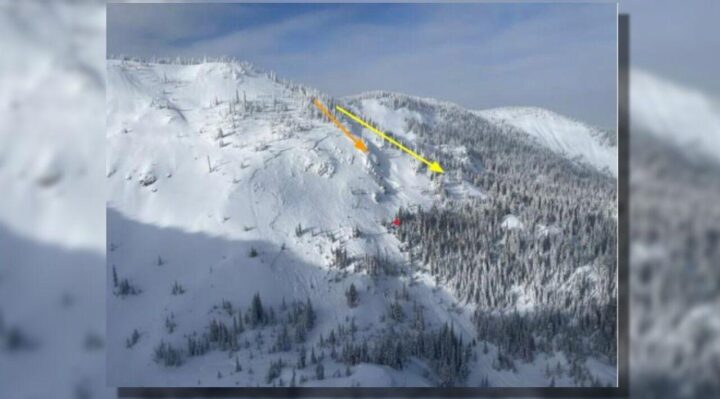
STEVENS PEAK, Idaho — The Idaho Panhandle Avalanche Center has released preliminary information regarding an avalanche that occurred on Jan. 11 that left one skier dead.
On Jan. 11 at 8:14 a.m., three skiers left for Stevens Lake Winter Trailhead aiming to ascend into the Loon Lake drainage below Stevens Peak. The skiers emphasized that their goal was to “seek out safe skiing options… and decided to ski conservative terrain.”
As they reached the trailhead, each skier was equipped with suitable gear and practiced with their avalanche gear earlier in the season. Each skier also had undergone avalanche training, possessed familiarity with the terrain and were experienced backcountry skiers.
They left the trailhead at 3,500 feet and descended their first run off the ridge around 12:14 p.m.
On their second descent, the skiers chose a slope with varying angles and intermittent islands of trees.
Skier 1 descended at 400 vertical feet then radioed at a safe location to skier 2 that they were clear.
As skier 2 descended at 2 p.m., a small, localized avalanche around a foot deep was triggered. The avalanche fully buried skiers 1 and 2, with skier 3 witnessing the event from above before beginning a search.
Skier 3 quickly located skier 2 whose airbag was deployed and visible. Skier 3 dug out skier 2 in the tree line and was able to pin his body against a tree, clear his airway, but there were no signs of life.
Skier 1 was carried in the avalanche debris and stopped near the avalanche “toe.” He was able to deploy his airbag while being carried with the slide.
Around 2:18 p.m., skier 1 communicated a SOS message to skier 3 using a Garmin InReach, which was transmitted to the Shoshone County Sheriff’s Office.
Skier 1 and 3 attempted to build a shelter to get warm, however, with the cold temperatures they decided to move towards the trailhead.
The Shoshone County Sheriff’s Office notified Shoshone County and Kootenai County Search and Rescue teams, members of the Silver Mountain Ski Patrol and members of the Northern Rockies Avalanche Canine team about the SOS message. Law enforcement told both skiers to stay where they were so a helicopter rescue could be arranged.
After waiting over two hours, skiers 1 and 3 were advised to begin hiking out due to poor visibility and gusty winds. They were met by members of the Silver Mountain Ski Patrol who helped them up to the trailhead.
Both skiers were transported out by an ATV and were brought to an ambulance at the trailhead.
On Jan. 12, Spokane SAR air support unit was dispatched to recover the body of skier 2. The helicopter made several passes over the avalanche but were not able to locate the body. Around the same time, a ground team entered the area and were able to spot skier 2’s deployed red airbag.
A paramedic and another rescuer repelled into the site and recovered the body.
The 2023-2024 winter season started slow but at the beginning of the new year, winter had finally arrived.
On Jan. 11, the day of the accident, snow totals from a nearby weather station at Silver Mountain recorded 29.7” of new snow since Jan. 3, which doubled the depth of the snowpack in most locations. With this, there were strong winds in the 20-30 mph range, with 45-60 mph wind gusts.
At the time of the avalanche, there wasn’t an active avalanche warning in place but the general information bulletin stated:
“Recent snowfall and winds have created slabs of unstable snow at tree lines and above. Human triggered avalanches remain likely on terrain steeper than 30 degrees. Terrain below ridgelines facing north and east has been loaded by winds, slabs will be more dangerous and likely to be triggered in those locations.”
“On Thursday the “avalanche warning” that was present Tuesday through Wednesday is being discontinued. It is important to know that conditions remain dangerous out there for backcountry riders. Although we do not meet criteria for HIGH avalanche danger, it is strongly advised that you avoid riding in steep terrain today, especially in locations that are loaded in by the recent winds.”
With research done by IPAC Forecasters, they found that the avalanche occurred on a slope angled 35 to 39 degrees. A small avalanche initially broke within the upper snowpack, likely the new/old snow interface, but stepped down to a weak layer near the base of the snowpack. Based on the report from the survivors and the site visit, it appears the initial avalanche was triggered from a point between protruding rocks where the snow may have been shallower and weaker than expected.”
“In an honest assessment, hard truths must be faced,” while the three skiers had a conservative mindset, human factors played a part in the accident.


